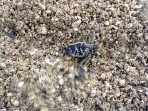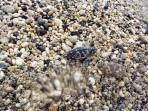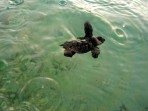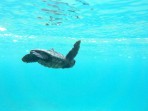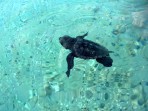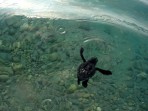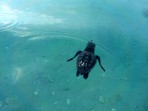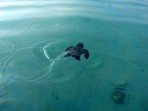Loggerhead sea turtle (Caretta Caretta) - island of Zakynthos
Zakynthos National Marine Park
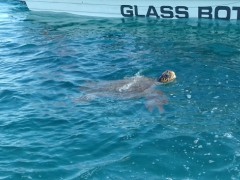
The Caretta Caretta turtle is an endangered species and can still be seen in the Mediterranean Sea, which is its home. During the breeding season, female common turtles come to the beaches of Laganas Bay to lay their eggs in the sand. The protection of the island's endangered species (not only the water turtles) is handled by the Zakynthos National Marine Park.
Caretta caretta (Loggerhead turtle)
Caretta caretta turtles are reptiles that can grow to a considerable size - adults can reach a size of more than 1 metre and weigh up to 140 kg (the smallest are about 80 cm). Despite this, the turtle is very fast in the water, reaching speeds of up to 30 km/h thanks to its large front flippers and stiff rear flippers, protecting itself from potential danger. Although they breathe air using their lungs, they spend almost all their lives underwater, where they feed on jellyfish, molluscs and other invertebrates.
Giant caretes migrate throughout the Mediterranean, but in spring they move from their feeding grounds in the Mediterranean to the Gulf of Laganas to breed. During the breeding season, the Caretta turtle always returns to the same beach where it was born, which is why it is important to preserve the breeding conditions in the Gulf of Laganas. The breeding season runs from May (or June) to August (or September). During this time, the ducks come to the beaches of the bay and wait for the night when the females come ashore and lay their eggs in the sand.
While the ducks are very agile in the sea, they are very vulnerable on land. Due to their size, they are slow and, unlike other turtle species, cannot retreat into their shells. On the beach, females check the terrain, the distance from the sea, the temperature and the quality of the sand to choose the best place to lay their eggs. They then dig a hole about 50 cm deep with their fins and lay an average of 120 eggs. This process is repeated 3 to 4 times during the summer. The eggs of the common eider are small and soft so that they cannot break if they fall. However, the females are very sensitive to noise or light and if disturbed will return to the sea without laying eggs. During the season, an average of 1 300 nests appear on the beaches along Laganas Bay. Hatching lasts about 50 days and approximately 60 % of the eggs hatch. In addition, the temperature of the sand determines the sex of the hatchlings.
Hatchlings measure about 5 cm after hatching and usually emerge from the nest at night. They move towards the sea, following the horizon and the moonlight reflected in the water. However, only a small percentage of them survive, as there are many obstacles and artificial lights all around the beach, which disorient the chicks. Even in the sea, however, they are not yet out of the woods, because even here they are still in danger, and it is reported that only one out of a thousand hatchlings will grow up.
The National Marine Park of Zakynthos
Zakynthos National Marine Park was established in 1999 with the main aim of protecting the natural heritage of the island and the specific species that live in its southern part. Among the most endangered are the Caretta Caretta turtle and the Mediterranean Monachus Monachus seal. In addition to these, other species are also protected by the organisation. Migratory birds such as wild swans, swallows, kingfishers and gulls regularly visit the southern part of the Gulf of Zakynthos and Strofada. There are many frogs, turtles, iguanas, porcupines and wild rabbits in the inland waters, and the dolphin Tursiops Truncatus can also be seen in the sea.
Zakynthos Marine Park covers the area along the southern coast from Cape Marathia to Gerakas beach, including Limni Keri, Laganas and Kalamaki beaches, as well as the two small islands of Strofades, which lie to the south of Zakynthos.
The symbol of the National Marine Park is the turtle. The organisation is based in the capital Zante on El Venizelou Street. The Caretta Caretta sea turtle exhibition centre is located near Dafni beach.
Zakynthos National Marine Park, however, operates as a non-profit institution and although it has its own guides, rangers and volunteers, it has to rely heavily on the responsibility of the tourists themselves and their willingness to abide by the rules set.
Rules of conduct in protected areas
General rules in Zakynthos National Marine Park: no open fires, no tents or other dwellings, no littering and no picking of plants and flowers.
On beaches where sea turtles nest it is forbidden to: enter the beach between sunset and sunrise, stick umbrellas in the sand and dig holes (building sand castles and other tourist activities should be limited to a zone only within about 3 m from the sea), touch the cages protecting the turtle nests, use bicycles, enter with horses, use torches and other light sources at night.
As far as the offshore protection zones are concerned, they are divided into three zones: in zone C, boats are allowed to enter and anchor, but only their speed is limited; in zone B, the speed at which boats can sail is limited, plus they are not allowed to anchor there; in zone A, boats are completely prohibited from entering.
Zakynthos National Marine Park website: www.nmp-zak.org
Did you visit this place and do you have some additional informations, interessting observation or photos?












